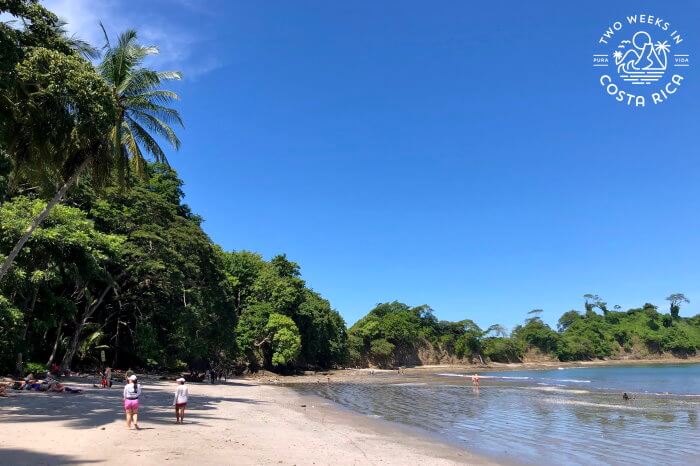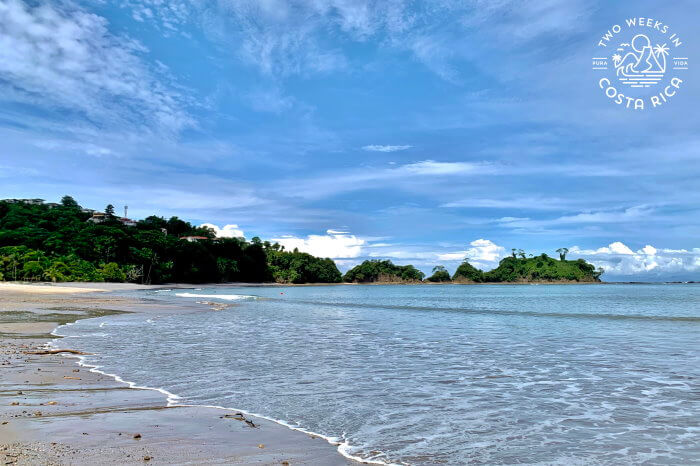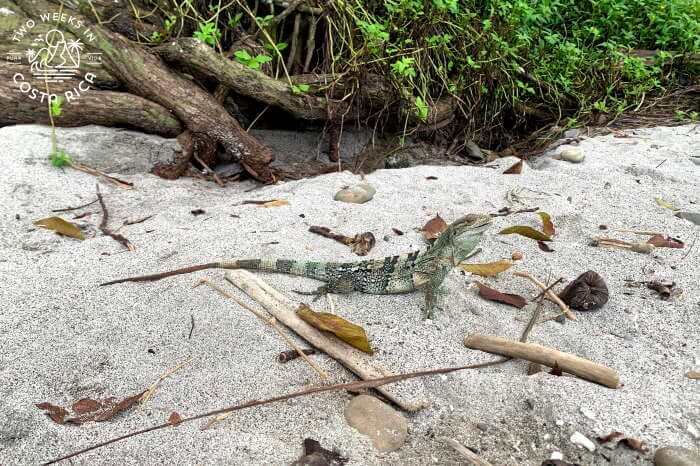Last Updated: June 8, 2024
While much of Costa Rica’s central Pacific coast has larger waves for surfing, there are a few beaches with nice calm water. One such place is Playa Mantas. This cove, just north of Jaco, has turquoise water and a thick backing of jungle. Because of its beauty, it is a popular spot. In this post, we’ll explain more about the beach and give some tips on the best times to visit.
IMPORTANT: See Parking section, below, for new restrictions on parking at Playa Mantas.

Orientation
Playa Mantas is located about 15 minutes north of the tourism hotspot, Jaco. It is not far off Highway 34 and can easily be visited on a day trip from Jaco. See directions below.
Playa Mantas is one of the closest scenic beaches to San Jose, at just over one hour. Because of this, it is very popular among locals. Costa Ricans from the capital city and elsewhere flock to this beach on weekends.

Playa Mantas is one of the beaches that fronts Punta Leona Resort. Punta Leona is a fairly large, more basic all-inclusive resort. It is spread out along the beach, and has different sections with bungalows and condos.
Punta Leona also has direct beach access to the neighboring Playa Blanca (see more below). Since all beaches in Costa Rica are public, you can access Playa Mantas and Playa Blanca even if you’re not staying at the resort.
About Playa Mantas
Playa Mantas is a wide cove, flanked by a rocky outcropping on one end and a vegetated point on the other.
The sand is a pretty gray color. The waves are gentle and perfect for swimming, even with young kids. In dry season when there is little rain (December to end of April), the water is a gorgeous turquoise shade.

The northern end of the beach is the quietest because it is the farthest from the main path.
This stretch, in our opinion, is one of the nicest parts of the beach. A steep green hillside backs the sand, creating a layer of shade during much of the year. A large outcropping of rocks forms the northern boundary. Here, you can find crabs and other sea creatures, making it a fun spot to explore.

There are also the remnants of some pilings here, probably from an old dock. We’ve seen people walk out to this area for pictures.
The middle section of beach is the busiest. This is because it’s right where the path from the public parking lot ends.
This area has some tall palms and thick shrubs. Large groups set up here for the day, or even the whole weekend. You’ll see barbeques, tables with food and drink, and maybe even tents for camping.

The southern end is also very pretty. This area has more palm trees and several thick, shady almond trees. The very southern end has large rocks that form pools at low and mid tide.

Access to Playa Mantas
Parking
Unlike most beaches in Costa Rica, Playa Mantas has a designated parking lot. Previously, there was a large parking lot operated by the municipality. However, as of August 2022, Club Punta Leona is now administering this lot and it is closed to the public.
The public now must park in a small dirt lot right before the large lot. This has about 40 spaces and fills fast, especially on the weekend. If you’re planning to go on a Saturday or Sunday or over a holiday, arrive early (before 9:00 am is best) to get a spot.
Informal attendants will watch your car in exchange for a tip. We give around 2,000-3,000 colones ($4-6) for the day.
There are no other options for parking in the immediate area.

Mini-Buses
If you are visiting on the weekend and the public lot is full, you can take a buseta (mini-bus). They let you park in their private lot, then bring you to the beach. You then contact them when you’d like to be picked up.
These buses are available towards the beginning of the main road to Playa Mantas. You will see people by the main road trying to get you to park.
The cost to take the mini-bus is around 5,000 colones (about $10) per car.
Wildlife
One of the cool things about Playa Mantas is that you can often see wildlife.
White-faced monkeys love to hang out in the middle area where there are a lot of people. These guys can be aggressive, so be sure to keep an eye on your bags. They will try to steal your food!
You also can see Scarlet Macaw parrots. These are big red birds with blue and yellow that are relatively common in the Jaco area, but still special. They feed in beach almond trees. You can often hear their loud squawk before you see them.
We’ve also seen iguanas, Jesus Christ Lizards in the stream along the walking path, and pelicans feeding in the sea.

Playa Blanca
Another highlight of Playa Mantas is its proximity to Playa Blanca.
Just on the other side of the southern point is this gorgeous beach.
Playa Blanca has fluffy white sand. This may seem like a small detail, but most of the sand on the central Pacific coast is volcanic and fine. At Playa Blanca, the texture is thicker, making it feel nice and fluffy under your toes.

You can’t drive to Playa Blanca unless you’re a guest at the Punta Leona Resort. But you can access it by walking south along the sand from Playa Mantas. This is best done at low tide.
Read our post, Playa Blanca: A White-Sand Oasis Near Jaco, for more details.
Directions to Playa Mantas
Take the coastal highway 34 to Punta Leona. If you’re coming from Jaco, the road to Playa Mantas will be on the left, shortly before the main entrance to Punta Leona Resort. Look for the large restaurant, Los Guarumos, as you’re coming down the hill. The left is a few hundred meters after that.
This is called Calle Vieja, the old road to Punta Leona.
There will be a tiny grocery store on the left after you turn and some condos. The road will be paved for a few minutes, then turn to dirt (usually with many bumps). This stretch is rainforest-covered and not very developed.
When you get closer to Punta Leona, it’ll turn to bumpy pavement again. You’ll pass some houses and condos, another mini-super grocery store, a pizza restaurant, and Pops ice-cream shop.
After driving for about ten minutes total, you’ll come to the parking lot on the right.
4×4 is not necessary for the drive but be careful as the road is very narrow in some places.
Conclusion
Playa Mantas is definitely one of our favorite beaches along Costa Rica’s central Pacific coast. Although it can be busy on weekends, this is also a fun, festive time. From your beach chair, you can catch a glimpse of the local culture, all while enjoying the beautiful tropical scenery.
Have a question about visiting Playa Mantas? Ask us below.
Last Updated: June 8, 2024
Looking for more information to plan your trip to Costa Rica? Check out these posts:
Jaco Tours: For more things to do in the Jaco area, check out this list of tours we can help you book.
Jaco: Costa Rica’s Booming Beach Town – Jaco has a fun vibe and great restaurants. Check out our post for what to expect as well as hotel and food recommendations.
La Fortuna: What to Expect – La Fortuna/Arenal pairs well with a visit to the Jaco area. Our post has details on things to do like volcano hikes and ziplining as well as tips on where to stay.
Best Beaches for Families in Costa Rica: Interested in visiting more beaches with calm water? This post has six ideas.

We visited here in our 2020 trip to Costa Rica after reading about it on your website. It was by far the best beach day of our stay. A little tricky to find that left turn off the main road but we did it!
Thanks for the tip.
Hi George and Lisa, Glad you made the trip to check out this beach and enjoyed it. It is a great one. Thanks for commenting!
Is there a place to rent beach chairs at Playa Mantas?
Hi Jill, Unfortunately, no. Beach chair rentals are not available. Only if you’re staying at Punta Leona Resort. Then you can use the chairs at the pool and at Playa Blanca.
Can you rent beach umbrellas and chairs on Playa Manta?
Hi Fernando, No, no one rents umbrellas or chairs on Playa Mantas, unfortunately.
Hi Jenn & Matt! My boyfriend and I will be traveling to Costa Rica in a few weeks and plan to stay at an Airbnb right near Punta Leona. I know the resort itself has some dining options, but we are hoping to explore some more authentic cuisine offerings. Jaco is not far of course, but we will not have a car and wondering if you might have any other local recommendations? Thank you!!
Hi Victoria, You’ll need to take a taxi but there are some authentic food options right on Highway 34 in Punta Leona. La Ostra and Los Guarumos are both very good.